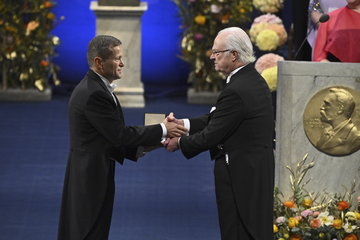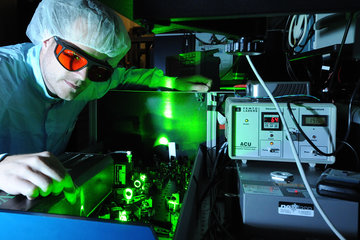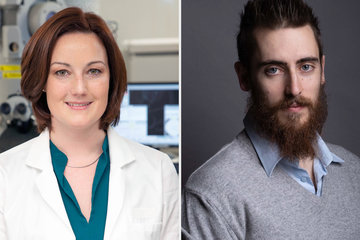CO2 recycling nominated for the European Inventor Award
For their contributions to sustainable chemical production, Walter Leitner and Christoph Gürtler have been selected as one of the three finalist teams
The two chemists have found a way to produce plastics from the greenhouse gas CO2. For this, the European Patent Office (EPO) has nominated Leitner – Director at the Max Planck Institute for Chemical Energy Conversion and Professor at RWTH Aachen University – and Gürtler – who is responsible for the development of new processes and products at Covestro AG – as finalists in the Industry category of the European Inventor Award 2021. The winners will be selected on 17 June.
The two nominees have played a considerable role in developing and launching the technology, which originated through the co-operation between application-oriented science and research-oriented industry. Their involvement in numerous patents relating to CO2 recycling is proof of this. Together, the two hold over 100 patents on the use of CO2 in the production of plastics. “The partnership between basic research and industrial expertise has laid the foundation for this development”, says Leitner. “It is a rare stroke of luck for both me and the junior researchers to be involved in such a process”.
Plastics containing CO2 used in mattresses, sports flooring, and cars

CO2 is difficult to activate into chemical reactions. The team led by Leitner and Gürtler solved this problem by precisely controlling the reaction between CO2 and the petroleum-based propylene oxide in the presence of a customized catalyst system that drives the reaction. In the process, the CO2 is firmly bound. “We worked closely together to develop the right catalyst that led to our success”, says Gürtler. The process is economically viable yet more sustainable than processes based solely on fossil fuels. The result is a polyol, which Covestro has marketed under the name cardyon®. It is already used to produce soft foam for mattresses, adhesives in sports flooring, cushioning in shoes, and various elements for car interiors. Elastic textile fibres are on the threshold of market maturity. Research projects have successfully demonstrated that CO2 can also be used as an insulating material made of rigid foam as well as for surfactants in detergents.
Launched in 2006, the Inventor Award of the EPO honours outstanding European inventors and teams in five categories and is one of the most prestigious awards of its kind. The award ceremony on 17 June will take place digitally for the first time and will be broadcast live over the internet. Three teams are nominated in the Industry category. “The nomination is an important confirmation of our efforts to make chemistry more sustainable. It shows how crucial patents are for the development of a technology”, says Gürtler. “It’s a great honour to be at the awards ceremony representing the interdisciplinary team from product research, process development, and marketing as well as the many other minds behind the invention”.
A contribution to the closed-loop economy in the chemical industry

The researchers at the CAT Catalytic Center, which was founded by Covestro and RWTH Aachen University in 2007, played a key role in this development. “Scientists have long been trying to figure out how to use carbon dioxide as a source of carbon for plastics. They’ve been working on this question for almost half a century”, explains Leitner.
The use of CO2 makes an important contribution to the closed-loop economy in the chemical industry. By partially replacing conventional petroleum with CO2 as a carbon source, valuable resources are conserved. Because the carbon remains in the cycle, less CO2 is released into the atmosphere. Initial studies suggest that this technology can also be used to produce more eco-friendly plastics, the components of which can be more easily recycled. An all-round sustainable innovation. At the Max Planck Institute for Chemical Energy Conversion, Leitner’s team is now working on further processes in which CO2 serves as a carbon source. Among other things, they use hydrogen, which can be produced with wind or solar energy.
The two nominees have played a considerable role in developing and launching the technology, which originated through the co-operation between application-oriented science and research-oriented industry. Their involvement in numerous patents relating to CO2 recycling is proof of this. Together, the two hold over 100 patents on the use of CO2 in the production of plastics. “The partnership between basic research and industrial expertise has laid the foundation for this development”, says Leitner. “It is a rare stroke of luck for both me and the junior researchers to be involved in such a process”.
Plastics containing CO2 used in mattresses, sports flooring, and cars
CO2 is difficult to activate into chemical reactions. The team led by Leitner and Gürtler solved this problem by precisely controlling the reaction between CO2 and the petroleum-based propylene oxide in the presence of a customized catalyst system that drives the reaction. In the process, the CO2 is firmly bound. “We worked closely together to develop the right catalyst that led to our success”, says Gürtler. The process is economically viable yet more sustainable than processes based solely on fossil fuels. The result is a polyol, which Covestro has marketed under the name cardyon®. It is already used to produce soft foam for mattresses, adhesives in sports flooring, cushioning in shoes, and various elements for car interiors. Elastic textile fibres are on the threshold of market maturity. Research projects have successfully demonstrated that CO2 can also be used as an insulating material made of rigid foam as well as for surfactants in detergents.
Launched in 2006, the Inventor Award of the EPO honours outstanding European inventors and teams in five categories and is one of the most prestigious awards of its kind. The award ceremony on 17 June will take place digitally for the first time and will be broadcast live over the internet. Three teams are nominated in the Industry category. “The nomination is an important confirmation of our efforts to make chemistry more sustainable. It shows how crucial patents are for the development of a technology”, says Gürtler. “It’s a great honour to be at the awards ceremony representing the interdisciplinary team from product research, process development, and marketing as well as the many other minds behind the invention”.
A contribution to the closed-loop economy in the chemical industry
The researchers at the CAT Catalytic Center, which was founded by Covestro and RWTH Aachen University in 2007, played a key role in this development. “Scientists have long been trying to figure out how to use carbon dioxide as a source of carbon for plastics. They’ve been working on this question for almost half a century”, explains Leitner.
The use of CO2 makes an important contribution to the closed-loop economy in the chemical industry. By partially replacing conventional petroleum with CO2 as a carbon source, valuable resources are conserved. Because the carbon remains in the cycle, less CO2 is released into the atmosphere. Initial studies suggest that this technology can also be used to produce more eco-friendly plastics, the components of which can be more easily recycled. An all-round sustainable innovation. At the Max Planck Institute for Chemical Energy Conversion, Leitner’s team is now working on further processes in which CO2 serves as a carbon source. Among other things, they use hydrogen, which can be produced with wind or solar energy.
Covestro/PH














